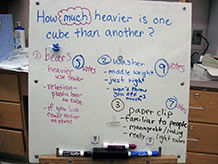How can we measure the weights of our cubes?
3. Make meaning
Purpose of the discussion
As a result of this discussion, students recognize that they need to have a uniform or standard unit of weight in order to compare weights. If they don’t do it spontaneously, they are prompted to use the class data table to support this claim.
Provide strategies for reading the data table
What can the students discover in the class data table? First ask them to look at the data in each column.
- What can be observed about the weight of the aluminum cube? The PVC cube? The acrylic cube?
- Is the data difficult to interpret? Why?
In fact, the data is likely to be very difficult to interpret because the groups had so many different units of measure to choose from.
Next ask students to look across each row.
- Did the groups all use the same kinds of measures?
- How do the weights of the cubes compare?
- Will the data help to build a good weight line? (Probably not)
Engage students in the focus question
Based on our class data, how can we compare the weight of our cubes?
Without consensus about the unit of measure, there can be no direct comparability. Some classes will grasp this point right away; others not at all. Work toward the understanding as best you can.
| Group # | Aluminum Cube | PVC Cube | Acrylic Cube |
|---|---|---|---|
| 1 | |||
| 2 | |||
| 3 |
Note: While the paper clips will provide the most accurate measurement, students must use more than 100 of them to weigh the copper cube.
First see if any of the groups used a single unit of measure for all three cubes. If yes, ask what their reasoning was for doing so, and have them use their data to arrange the cubes in a weight line. If not, pursue the question inquiry–fashion:
- I wonder how we could compare these weights better. Who has an idea?
If this fails, propose the strategy yourself:
- What if we used just one of the measures to weigh all the cubes? Would that help?

Before voting on the class measure, students in this class listed the pros and cons of each counting unit.
Ask the class to share ideas about which unit to use: paperclips, washers, bears — or maybe some other unit altogether. Listen to the arguments for and against each unit, and then ask the class to vote. When they have agreed on which measure to use, record the decision for the class.
Return to the investigation question:
Ask the class whether they think they are closer to making a good weight line.



